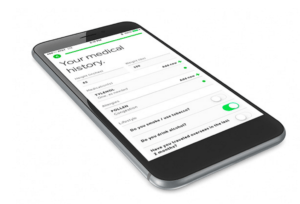Teladoc: Mobile Medicine
Telemedicine is transforming the way that patients and doctors interact, turning your office into the doctors office with a click of your smart phone.
The US medical industry is in the midst of a major transformation with new regulations and technologies disrupting the traditional operating model across multiple dimensions. One of the biggest shifts in recent years has been the advent and adoption of telemedicine.
Traditionally medical visits have required patients to travel to a physician’s office or community clinic in order to receive treatment. This process is both costly and time intensive. The problem is exacerbated in urgent care situations in which a patient needs treatment quickly and cannot afford to wait for their doctor’s next available appointment. A patient in this instance is typically rerouted to their local hospital’s emergency room, where they wait for hours and pay $1,957 on average to see an on call physician [1]. If they require follow up treatment, they need to repeat the process yet again.
Telemedicine has fundamentally uprooted this process by allowing patients to connect with doctors remotely and often from the comfort of their own homes. Teladoc, founded in 2002, is pioneering this technology.
Company Facts:
- Teladoc is public company with 17+ million members and a network of 3,600 licensed medical professionals
- Most of their consultations are set up within 10 minutes
- 92% of patients’ issues are resolved after the first visit
- A Teladoc consultation costs $45 compared to an office visit in the US which costs $100 more on average
- Customers save $717 per episode of care [1]
Teladoc offers consumers and businesses a convenient and cost-effective alternative to traditional doctor’s visits and trips to the emergency room. Their entire business platform is enabled by smartphone technology and high-speed wireless internet connections. Through their platform, doctors assess patients remotely and can issue diagnoses and even write prescriptions virtually.
Telemedicine is offered through either “‘live’, real-time transmission or store and forward transmission” [2]. While a lack of broadband infrastructure previously hindered the widespread adoption of telemedicine, it is now a technologically-empowered reality. The build out of the communication system was boosted in 2010 through the Obama administration’s proposal, Connecting America: The National Broadband Plan [3]. Today, patients in remote locations can receive the same quality of care as those in major US cities.
Across the country hospitals have implemented the same telemedicine technology to offer hospital-to-hospital care to remote institutions within their networks, providing world class medical treatment to an entirely new set of patients who previously lacked the access and/or means. In fact, 72% of hospitals and 52% of physician groups now offer telemedicine programs [4]. Mercy Health System, for example, has implemented a “Virtual Care Center” that offers support to ICUs and ERS in 38 hospitals across the southeast. Their program has already saved 1,000 lives and decreased average patients’ stay by 35% [4].
As the telemedicine industry evolves it must tackle regulation and insurance head on. Currently, each state has jurisdiction over medical regulations and licensing fees, meaning that telemedicine may be defined differently from one state to a next. This limits what types of medical practices can be authorized through telemedicine in various parts of the US. Additionally, a physician is required to be licensed in the state in which their patient resides [4], limiting the number of patients that can regularly and readily be covered through telemedicine systems.
Moreover, insurance has been slow to adopt telemedicine as a replacement to traditional office visits. While health plans have welcomed telemedicine as a means of treating urgent-care patients, they are “far less willing to pay for telemedicine when doctors use phone, email or video to consult with existing patients about continuing issues” [4]. Doctor-to-doctor consultations, in which physicians at top facilities advise or support smaller hospitals in their network, are also unpopular with insurance firms and are rarely reimbursed. Medicare and Medicaid lag even further behind private insurers and currently only cover telemedicine if it is offered to patients in rural areas while they are presently at a medical facility [4].
Telemedicine bills have been proposed to Congress and progress is being made as more and more patients opt out of the traditional doctor-patient model and move to remote access. Telemedicine is not a replacement for all in-person medical treatment but it is quickly becoming the method of choice for certain types of treatment, such as dermatological problems, general health and behavioral health assessments [1]. Broadband technology has not only disrupted the century-old doctor office model but it has also opened up access for new populations who had never before dreamed of receiving the quality of care now available at the touch of their fingers.
Word count 755
- Teladoc Company Website https://www.teladoc.com/businesses/save-money/
- AMD Global Telemedicine http://www.amdtelemedicine.com/telemedicine-resources/telemedicine-technology.html
- Gruessner, Vera. “The History of Remote Monitoring Telemedicine Technology.” mHealth Intelligence. 9 Nov. 2015 . Web. 17 Nov. 2016. http://mhealthintelligence.com/news/the-history-of-remote-monitoring-telemedicine-technology
- Beck, Melinda. “How Telemedicine Is Transforming Health Care.” Wsj.com. Wall Street Journal, 26 June 2016. Web. 17 Nov. 2016.





Very interesting article, Caroline! I am still amazed at how most consultations can be set up in just 10 minutes considering each medical professional on average serves about 4700 patients (17+ million members/3600 medical professionals). I think telemedicine has great potential to help people who otherwise would have no access whatsoever to physicians. Nevertheless, telemedicine has to overcome quite a few challenges before it becomes mainstream. As is highlighted in this article (http://www.rmmagazine.com/2016/08/01/the-benefits-and-risks-of-telemedicine/), data privacy/security is a big issue. Even with the advent of technology, today, medical reports are still rarely sent through the internet since information sent online can be easily intercepted without strong security systems. This will be one of the key challenges that telemedicine has to deal with.
Super interesting read, Caroline! Beyond the first frontier of lowering cost of healthcare for people that already have access, I think there is incredible potential for telemedicine to bring healthcare to people in remote areas, particularly in the developing world, who would otherwise not have access to specialists. Of course, there are many infrastructure issues to overcome before this becomes a truly revolutionary solution, but given advances in other technology (including 3D printing which would allow remote printing of, for example, custom prostheses), telemedicine has the potential to significantly improve the quality of life for millions of people around the globe.
Great post, Caroline! I have a friend working on a startup in the tele-health space and was talking to her this weekend about the opportunities and challenges this kind of technology faces. A lot of diagnosis by a doctor is in very subtle body, behavioral and non-verbal cues, which risk getting lost via a digital solution like a video appointment. One way around this that my friend’s company is exploring is to augment the doctor with machine learning that can process the video feed in real time to look for flags for specific conditions. This could eventually also help reduce the amount of time doctors and physicians need to spend in these kinds of first or second time visits, which would also help on the cost side of the equation.
Thanks for the article Caroline. I was really surprised that this company has been trying to do this since 2002, one would think there must have been a significant progress in 14 years in terms of implementation and reach, but apparently they’re still struggling with governmental regulation. Furthermore, I do think it is a behemoth of a challenge, given the fact of how hospitals work (like workshops) because of all the different possibilities of complications and diseases. Nevertheless, I agree that there’s a significant part of the health care visits that can be done through video or phone, dropping the overall cost of care. Plus, taking into consideration the upcoming Virtual / Augmented Reality technologies in the short term, the setbacks that we see in accuracy today, may not be present in the future if one of these technologies are used to provide care.
Super interesting article Caroline. Telemedicine seems to be making great strides in reducing the monetary and temporal costs of healthcare, leveraging digital platforms to connect doctors and patients in innovative ways. Given that health care costs continue to grow at a higher rate than inflation, I am all for anything that is able to “bend the cost curve” and slow the growth in real health care spending growth rates. I wonder, however, where there is even more that telemedicine companies can do on this front.
For instance, a doctors time is one of the most expensive components of health care delivery. I wonder whether the digital platforms that telemedicine providers can be used to create methods of preventative care that alert patients to issues and alter their behavior before issues worsen to the point where a doctor, and the related intelligence and discretion of human-provided care, are required. For instance, are there types of health and biometric data that these platforms can track to alert a patient to unhealthy practices or possible issues requiring immediate attention before they become worse issues? If so, even greater strides can be made to reducing healthcare costs.
Great topic and very important considerations. The potential is enormous and I feel particularly excited with the possibility of bringing quality healthcare in undeserved regions (less privileged / hard to access areas). I can see it working very well to deliver primary care in the rural areas of Brazil, for example, where it has been hard to attract physicians. It is such a challenge that the government in Brazil started to sponsor the immigration of physicians from Cuba to fill this gap (1). However, it was a very controversial action due to the different standards for medicine degree between the two countries.
My only reservation is that many diagnosis came from non-spoken cues, which I believe is harder to get from the app. However, I think the benefits outweigh the risks and that this is the right way to go.
(1) “Cuba’s Most Valuable Export: Its Healthcare Expertise”, Forbes, Jun 2015. http://www.forbes.com/sites/billfrist/2015/06/08/cubas-most-valuable-export-its-healthcare-expertise/#29dbf531325c
(2) “Brazil Seeks to Replace Cuban Doctors with Brazilians in Rural Health Program”, Wall Street Journal, Sep. 2016. http://www.wsj.com/articles/brazil-seeks-to-replace-cuban-doctors-with-brazilians-in-rural-health-program-1474463903
Phenomenal article Caroline!
Your article reminded me of IBM’s Watson case. As you mentioned, there are a significant number of diseases that could be consulted for and treated remotely. Beyond that, I wonder when companies will be able to use artificial intelligence to provide medical advice for general-doctor issues. This is quite a moonshot, but, Vinod Koshla at a speech at Stanford’s GSB did say that “doctors will not have a job in 2070”. I also wonder if lack of more progressive regulation will be the main obstacle for the improvement of mankind’s quality of life.